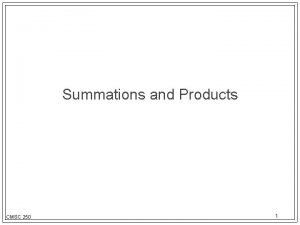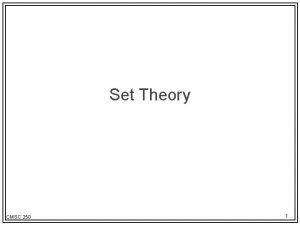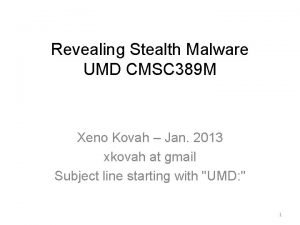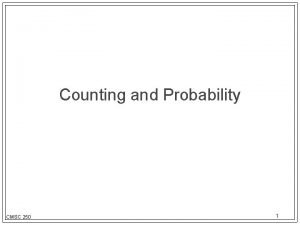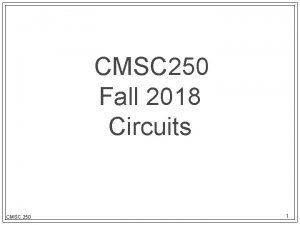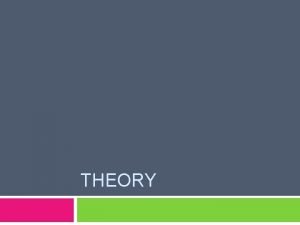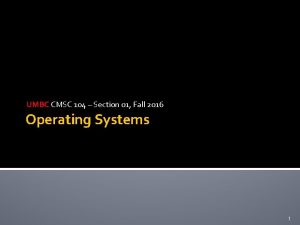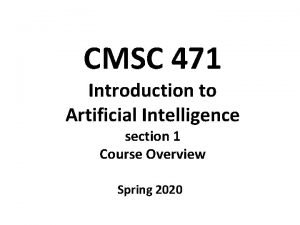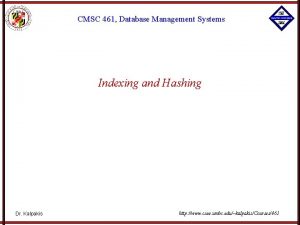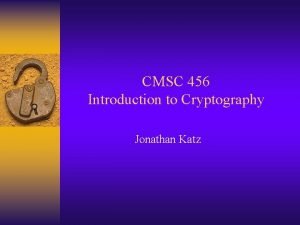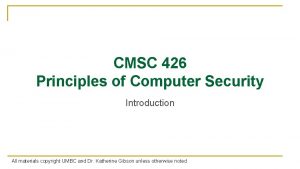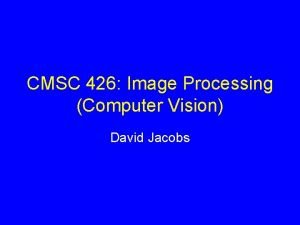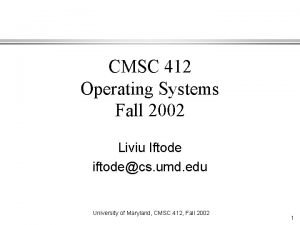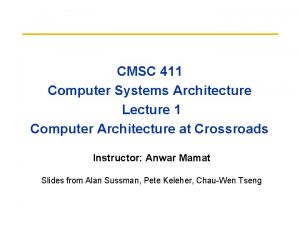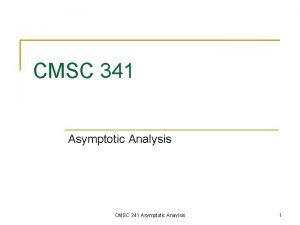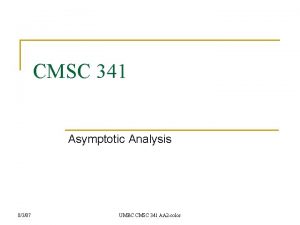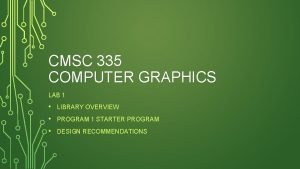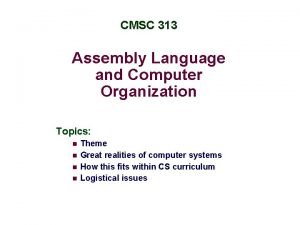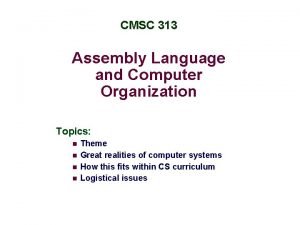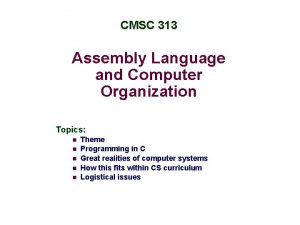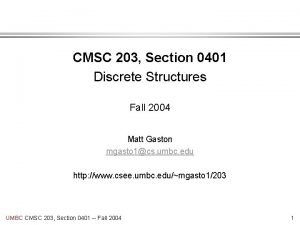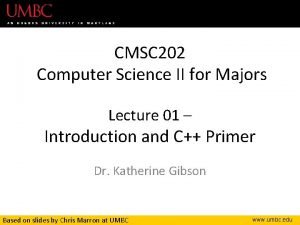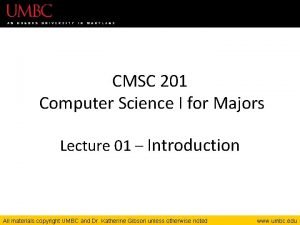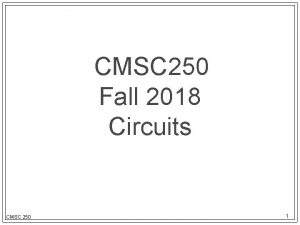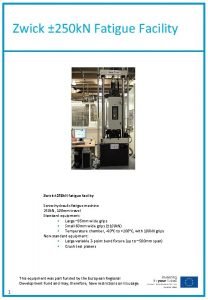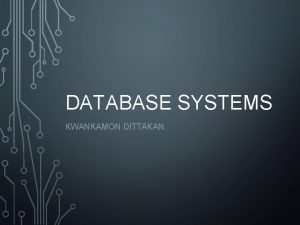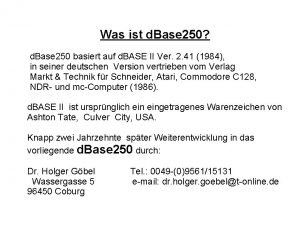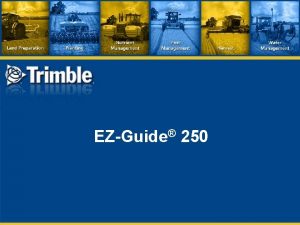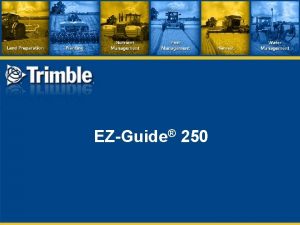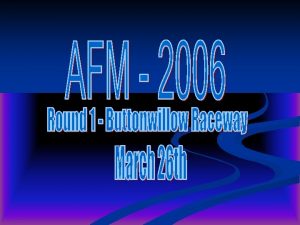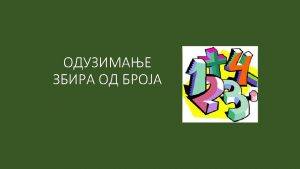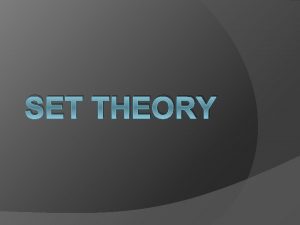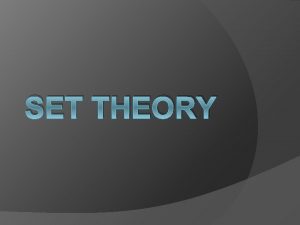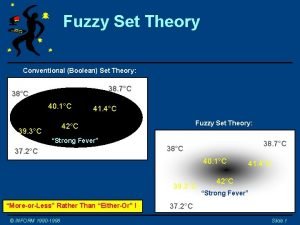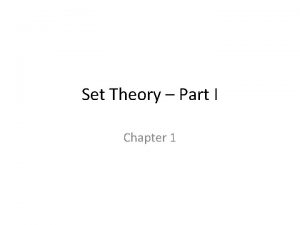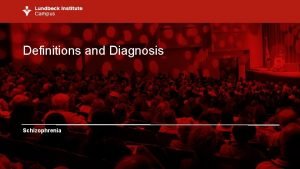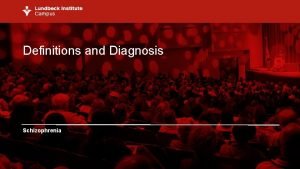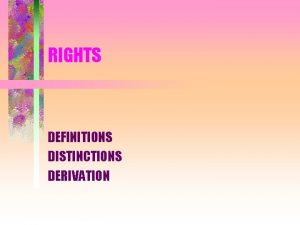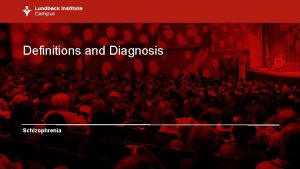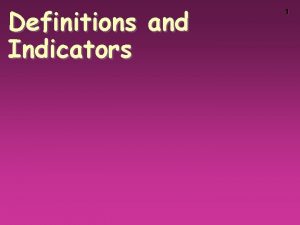Set Theory CMSC 250 1 Set definitions Definition



![Subset l A B ( x U)[x A x B] A is contained in Subset l A B ( x U)[x A x B] A is contained in](https://slidetodoc.com/presentation_image/439db92cc9015144533387b9edf6a8a9/image-4.jpg)










![Properties of power sets P(A) P(B)] l ( sets A, B)[A B l ( Properties of power sets P(A) P(B)] l ( sets A, B)[A B l (](https://slidetodoc.com/presentation_image/439db92cc9015144533387b9edf6a8a9/image-15.jpg)










- Slides: 25

Set Theory CMSC 250 1

Set definitions Definition: A set is a collection of objects. Examples: A = {1, 2, 3} B = {x Z | 4 < x < 4} C = {x Z+ | 4 < x < 4} A set is completely defined by its elements, i. e. , {a, b} = {b, a} = {a, a, a, b, b, b} CMSC 250 2

More set concepts l l l CMSC 250 The universal set U is the set of all elements under consideration A set can be finite or can be infinite For a set S, n(S) or |S| are used to refer to the cardinality of S, which is the number of elements in S The symbol means "is an element of" The symbol means "is not an element of" 3
![Subset l A B x Ux A x B A is contained in Subset l A B ( x U)[x A x B] A is contained in](https://slidetodoc.com/presentation_image/439db92cc9015144533387b9edf6a8a9/image-4.jpg)
Subset l A B ( x U)[x A x B] A is contained in B B contains A l A B ( x U)[x A x B] l Relationship between membership and subset: ( x U)[x A {x} A] l Definition of set equality: A = B A B B A CMSC 250 4

Proper subset CMSC 250 5

Do these represent the same sets or not? X = {x Z | ( p Z)[x = 2 p]} Y = {y Z | ( q Z)[y = 2 q 2]} A = {x Z | ( i Z)[x = 2 i + 1]} B = {x Z | ( i Z)[x = 3 i + 1]} C = {x Z | ( i Z)[x = 4 i + 1]} CMSC 250 6

Formal definitions of set operations Union: Intersection: Complement: Difference: CMSC 250 7

Venn Diagrams Sets are represented as regions to illustrate relationships between them. CMSC 250 8

The empty set and its properties The empty set has no elements, so = {}. 1. 2. 3. 4. 5. 6. 7. CMSC 250 ( sets X)[ X] There is only one empty set. ( sets X)[X = X] ( sets X)[X X = ] ( sets X)[X = ] U= =U 9

The Cartesian Product l The Cartesian product of sets A and B is defined as l |A B| = |A| |B| (size of A times size of B) CMSC 250 10

Ordered n-tuples l An ordered n-tuple takes order and multiplicity into account l The tuple (x 1, x 2, x 3, …, xn) – has n values – not necessarily distinct – order matters (unlike sets) l (x 1, x 2, x 3, …, xn) = (y 1, y 2, y 3, …, yn) ( i 1 i n)[xi = yi ] l 2 -tuples are called pairs, and 3 -tuples are called triples CMSC 250 11

Examples l (1, 3, 2) ≠ (3, 2, 1) l {1, 3, 2} = {3, 2, 1} l (1, 1, 3, 2) is a fine 4 -tuple l (1, 1, 3, 2) ≠ (1, 3, 2) l {1, 1, 3, 2} = {1, 3, 2} CMSC 250 12

Disjoint Sets l A and B are disjoint A and B have no elements in common ( x U)[x A x B] l A B = A and B are disjoint sets l If A and B are disjoint then |A B| = |A| + |B| What if A and B are not disjoint? CMSC 250 13

Power set P (A) = the set of all subsets of A Examples: What are P ({a, b})? P ({a, b, c})? P ({a})? P ({ })? CMSC 250 14
![Properties of power sets PA PB l sets A BA B l Properties of power sets P(A) P(B)] l ( sets A, B)[A B l (](https://slidetodoc.com/presentation_image/439db92cc9015144533387b9edf6a8a9/image-15.jpg)
Properties of power sets P(A) P(B)] l ( sets A, B)[A B l ( sets A)[ |P(A)| = 2|A| ] Proof in class CMSC 250 15

Properties of sets l Inclusion l Transitivity CMSC 250 16

More Properties of Sets l De. Morgan’s for complement l Distribution of union and intersection l There a number of others CMSC 250 17

Analogies between Sets and Logic l A B is analogous to A B l A l What is A implies B analogous to? CMSC 250 is analogous to A 18

Using Venn diagrams to help find counterexamples CMSC 250 19

Deriving new properties using Venn diagrams Proof in class CMSC 250 20

Partitions of a Set l A collection of nonempty sets {A 1, A 2, …, An} is a partition of the set A if and only if 1. A = A 1 A 2 … An 2. A 1, A 2, …, An are mutually disjoint l CMSC 250 An infinite set can be partitioned. The partitions can be infinite, or can be finite. 21

Russell’s Paradox A set can be an element or member of itself. Example: List of all lists. Set of infinite sets. l l Consider the set S = {A | A is a set and A A} – Is S an element of itself? CMSC 250 22

Russell’s Paradox Continued l S = {A | A is a set and A A} – – CMSC 250 Is S an element of itself? Option 1: YES! S S. Then by def of S, S S. Option 2: NO! S S. Then by def of S, S S. Upshot: S does not exist!!! 23

The Halting Problem Does such a computer program exist? INPUT: Program P, input x OUTPUT: YES if program P on input x halts NO if program P on input x does not halt An approach: Run P on x and see what happens. Does not work!: If it does not halt we will never know. How about a different approach? ? ? CMSC 250 24

Proof for the Halting Problem Suppose there is a program Halt(P, x) for the halting problem. Create a new program Test: procedure Test(P) if Halt(P, P)outputs YES then loop forever; if Halt(P, P)outputs NO then STOP; end procedure Now run Test(Test): – if Test(Test) halts, then Halt(Test, Test) outputs YES; hence Test(Test) does not halt. – if Test(Test) does not halt, then Halt(Test, Test) outputs NO; hence Test(Test) halts. CMSC 250 25
 Cmsc 250
Cmsc 250 Definition of power set
Definition of power set Umd cmsc 250
Umd cmsc 250 Cmsc 250
Cmsc 250 Cmsc 250
Cmsc 250 Total set awareness set consideration set
Total set awareness set consideration set Training set validation set test set
Training set validation set test set Examples of reciprocal determinism
Examples of reciprocal determinism Apple notes
Apple notes Cmsc 417
Cmsc 417 Cmsc 471 umbc
Cmsc 471 umbc Cmsc 461
Cmsc 461 Cmsc456 umd
Cmsc456 umd Umbc cmsc 426
Umbc cmsc 426 David jacobs umd
David jacobs umd Liviu iftode
Liviu iftode Anwar mamat umd
Anwar mamat umd Cmsc 341
Cmsc 341 Umbc cmsc 341
Umbc cmsc 341 Cmsc335
Cmsc335 Cmsc 313
Cmsc 313 Cmsc 313
Cmsc 313 Cmsc 313
Cmsc 313 Cmsc 203 umbc
Cmsc 203 umbc Cmsc 202 umbc
Cmsc 202 umbc Cmsc 201 umbc
Cmsc 201 umbc
